Posts | Building Tips | Energy Efficiency
3 Money-Saving Ways to Heat and Cool Your Pole Barn
Angie joined FBi Buildings in 2012 and is now the Director of Marketing. She's an avid reader and enjoys outdoor leisure and cheering on her two daughters at their sporting events.
Did you know that heating and cooling are the largest energy drains in post frame buildings with climate controlled spaces? If you think about it...it does make sense. Heat rises to the top of any building, and if your building isn’t well insulated what happens to the heat? It will escape through the top of your building, or around any windows and doors that aren’t properly sealed.
If you’re losing heat (or even air) around your windows and doors then you’re also wasting money on energy costs. Let’s think about how that concept works. Have you ever noticed that it takes forever for your furnace or even your air conditioner to stop running? That’s because it’s trying to keep up with heating or cooling your post frame building or even home. If there are leaks around windows, doors, or even in your attic then you’re wasting energy.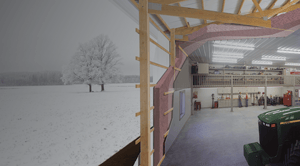 Do you know of anyone who lives in an old farmhouse and they have to run space heaters to keep their house warm enough during the winter? It’s a similar situation to that.
Do you know of anyone who lives in an old farmhouse and they have to run space heaters to keep their house warm enough during the winter? It’s a similar situation to that.
If your house has old wooden-framed windows and a front door that howls every time the wind blows, I can almost guarantee you that your home is losing heat. Do you have an attic that doesn’t have blown-in insulation? I can almost guarantee you that your home is losing heat. Why? Because heat rises to the top of any structure.
When you’re ready to move forward with your farm shop, horse barn, or even garage, keep in mind the different heating and cooling systems that are available for you to choose from. From multiple HVAC systems to ductless mini split, ductless heating, or ductless heat pumps.
All of these are options for your next pole building. Our recommendation (no matter what option you choose) is to make sure you find energy star items. The savings will benefit you in the long run.
Now is the perfect time for you to begin planning on how you will heat and/or cool your building this winter...and for many seasons to come. But remember, it is possible to heat and cool all or even a part of your building, and we can help you make the educated decisions about purchases and installations.
Before we begin, it is important to point out that some utility companies offer rebates for installation of high-efficiency systems. Check with your local utility company for details.
Fun fact: Did you know that you can get a tax credit by purchasing Energy Star heating and cooling options? You can, but you can only claim the credit one time. Ask your accountant for more information.
3 Money-Saving Ways to Heat Your Pole Barn
1. Furnaces
Furnaces create heat by burning fuel, usually natural gas or propane. Commonly used in homes, furnaces can also be used in post frame buildings and in fully finished interiors that require a forced air distribution system involving ductwork.
Where aesthetics and heating are not critical, such as a workshop, forced air heating units can be hung from the ceiling. And the best part? No ductwork is required. When you’re at the beginning stages of your post-frame building design, it’s important to think about what type of furnace you want to use (if you choose to use this option).
Buying advice: The efficiency of new furnaces is measured by the annual fuel utilization efficiency (AFUE), a measure of seasonal performance. For example, gas furnace models range from 78% to 96% efficiency.
2. Heat Pumps
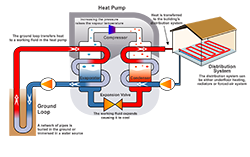
A more energy-efficient alternative to a furnace, a heat pump is an electrically powered, all-in-one heating and cooling forced air system that works year-round.
Its purpose is to transfer heat from one place to another. During the heating season, a heat pump extracts heat from an outside source and transfers the heat indoors.
In the summer, the direction of the heat flow is reversed, extracting heat from indoors and transferring it outdoors, to provide air conditioning.
The most common type of heat pump is an air-source heat pump, which transfers heat between your pole barn or post-frame building and the outside air.
Higher efficiencies are achieved with geothermal heat pumps, which transfer heat between your building and the ground or a nearby water source.
Buying advice: For heating purposes, heat pumps are rated by their “heating seasonal performance factor,” or HSPF.
Heat pumps are extremely efficient to operate, but you should be aware that compared to conventional systems they:
- Have a higher initial cost
- Take much longer to warm up or cool down a space
- Require movement of a higher volume of air
3. Radiant Heating Systems
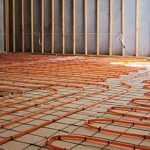
Radiant heating systems involve supplying heat directly from the ceiling or floor of a pole barn or post frame building. These are usually more efficient than forced-air heating because no energy is lost through ductwork. However, if you want cooling, you will have the cost of installing ductwork just for the A/C.
Radiant heat works by warming objects directly, instead of warming the air; therefore, it is highly recommended for post frame buildings with doors that are opened a lot.
There are 3 different types of radiant heating systems that we recommend:
- Surface-mounted radiant ceiling panels
These can be used to provide supplementary or zoned heat, or they can be used as the primary source of heating for an entire building. These panels can rapidly change a room’s environment; they heat quickly when turned on and cool quickly when turned off. 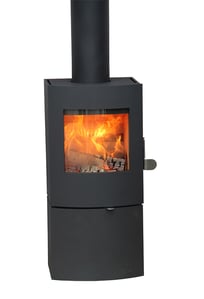 Radiant floor heating systems
Radiant floor heating systems
Which are significantly different from and have a higher initial cost than their ceiling-mounted counterparts – usually transmit heat with water. These systems take considerable time to heat up but retain their heat for a long time.- Stoves
Provide alternative heating sources and range from traditional wood-burning units to those that burn corn, oil or pellets made of compacted sawdust. They can either be installed inside your building or located outside and then connected to a forced-air component that is inside. The latter are typically wood furnaces. A reputable dealer should be able to explain the different options and talk with you about sizing a stove to your space.
You can use a stove as your only source of heat or to complement a forced-air heating system. Before considering a stove for economic reasons, however, you should also take into account the need to buy and store fuel, the time and effort required to tend the fire, and the fact that stoves may emit air pollutants that you would not get with a furnace or heat pump.
It’s also extremely important to make sure your duct-work is properly installed. Wood burning stoves get extremely hot and put off a lot of heat. A lot of heat means the room they're installed in gets very warm. If you prefer to work in the heat then this might not bother you.
Also, make sure your local building codes allow wood-burning appliances in new construction. There is a risk of fire with using stoves so some codes will not allow them.
3 Money-Saving Ways to Cool Your Pole Barn
Now that we’ve discussed how to heat your pole barn or post frame building it’s equally important to figure out how you’re going to cool it. Believe it or not, there’s more than just an air conditioner as an option.
But remember, all models will vary in efficiency ratings and have a direct impact on operating costs – so optimizing efficiency should be a priority.
1. Air-Circulating Fans
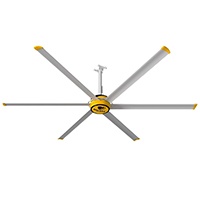 The use of fans can provide continuously moving air that produces a wind chill effect. Available options include:
The use of fans can provide continuously moving air that produces a wind chill effect. Available options include:
- Ceiling fans
- Portable fans
- Larger, installed fan units
- Or a combination of any of the above
Note: Most ceiling fans allow you to change the direction of rotation, which you should do when the seasons change.
2. Window-Mounted Air Conditioner Units
Window-mounted room air conditioners are the most energy-conserving choice if you only need to cool a small, specific area of your building. These cost less to install than a central air conditioning system and, of course, don’t require ductwork.
However, there is a downside to using this options. They aren’t attractive. Place them in a back window if curb appeal matters. These units are labeled with an energy efficiency ratio (EER); choose a unit with a high EER.
3. Central AC and Heat Pumps
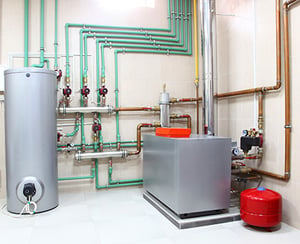 If you decide you want to cool all or a large portion of your building, you should consider installing a central air conditioning system or – for greater efficiency – a heat pump.
If you decide you want to cool all or a large portion of your building, you should consider installing a central air conditioning system or – for greater efficiency – a heat pump.
Remember: Your heating decisions for your post frame building can affect your cooling options.
Buying advice: For cooling purposes, both central A/C and heat pumps are rated according to their seasonal energy efficiency ratio (SEER). The higher the SEER, the more efficient the unit.
Don’t believe bigger is better. It might surprise you to know that buying a bigger air-conditioning unit won’t necessarily make you feel more comfortable during the hot summer months.
In fact, a unit that’s too big for the area it is supposed to cool will perform less efficiently and less effectively than a smaller, properly sized unit.
An A/C unit that is too big will not run often enough to keep the humidity low. This leaves occupants with a “cold-sticky” feeling. High humidity also promotes mold growth.
What Heating and Cool Option Will You Choose?
Have more questions about heating and cooling not covered in this article? Be sure to request our Energy Efficiency Brochure. If you have more questions once you read through it, we will be glad to talk through those over the phone.
Do you have more questions that are not covered in this article? If you need help designing and planning, please contact FBi Buildings at 800.552.2981 or click here to email us. If you are ready to get a price, click here to request a quote and a member of our customer engagement team will help you determine the next steps of your project.




